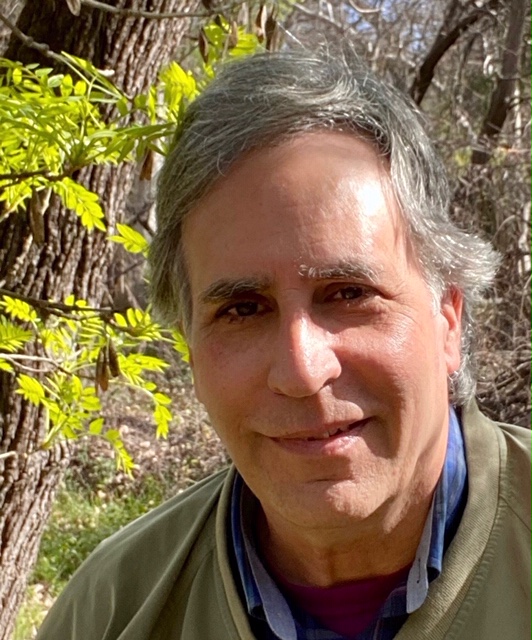Creative Writing: Summer Solstice
By Martin LeFevre
It¹s been very hot in California¹s Great Central Valley the past week. The creek beyond town has dwindled from streamlet to trickle to stagnant ponds in the space of that time. Water won¹t run again until the winter rains come, so it¹s the last sitting under the sycamore this summer.
With the creek a trickle, the traffic noise from the highway a mile away is pronounced. But it isn¹t too bothersome, and there are still the sounds of pheasants squawking in the fields, and of quail shrilly calling their new brood to cover.
Observation gathers attention, and the spontaneous combustion of meditation ignites. Thought has its place obviously, but when it is primary, it makes a terrible mess of things. The mind naturally and effortlessly quiets down when one knows how to observe the movement outside and inside without the infinite regression of the seemingly separate observer. Allowing the senses to receive impressions unfiltered, one feels one¹s inherent relationship to animals and all life.
A young, but nearly full-grown deer warily walks into the dense growth along the bank across the stream. In a meditative state, one can feel the cautiousness in its hesitant step and the flicks of its big ears. The deer and I stare at each other for some seconds, and the human-animal divide vanishes.
Humans used to be called the ³pinnacle of creation.² Though we seem increasingly to be its nadir, there is a potential truth in the statement.
Scientists say, ³ontogeny recapitulates phylogeny²--that is, the development of the individual from fertilized ovum repeats the development of a species over time. But an existing species also encompasses the evolutionary history of the animals that came before it.
In other words, go back far enough, and all animals on earth today share a common ancestor. And mammalian history is fairly recent, an explosive product of the space that opened up after the last great extinction event wiped out the dinosaurs about 65 million years ago.
That means the higher mammals have pretty much the same emotional structure as we humans do. Emotions such as fear, joy, curiosity, anger, and even love did not begin when humans came onto the scene.
Understanding animals, and communing with them, therefore begins and ends not with the scientific study of them as the ultimate Œother,¹ but through observing and understanding one¹s own emotions. The most important thing is to see how the intellect interferes with, exaggerates, or represses emotion‹all of which impede or impair the capacity to see and feel in the present.
The ability to consciously separate Œthings¹ from the environment, and generate symbols to stand for them, is what separates us from the rest of the animal kingdom. Though he had no transcendent vision of humanity, American anthropologist Leslie A. White was right when he said (in the sexist language of his day): ³There is a fundamental difference between the mind of man and the mind of non-manŠMan uses symbols; no other creature does. A creature either uses symbols or he does not; there are no intermediate stages.²
There is no return to some idealized, Rousseauian past when Œman¹ was one with nature. Rather, the human being moves beyond both the primal and modern mind, with their different obsessions with symbols. To see through the symbol (as word, image, idea, belief, or tradition) is not to see at all. Each time the symbol-using brain lets go of its dominance and ceases its chatter in method-less meditation, the human grows closer to a human being.
As the sun slips below the hazy outline of the Coastal Range, I ride the bike back in reverie and reverence for the earth, and the infinite mystery that is life. The darkness and misery of collective consciousness feels as far away, and relevant, as the distant noise from the vehicles on the highway.
Suddenly a falcon flies directly across my path. I stop and wait, and sure enough, the kestrel hovers over the field, its wings fluttering as it scans for prey. Then, like the descending notes at the end of the first movement of Beethoven¹s Symphony #3, this master of the air falls with pure grace to the ground, its wings held up and back.



 Ian Powell: “I Can Confirm They Are Hypotheticals Drawn Largely From Anecdotes And Issues The Minister Has Heard About.”
Ian Powell: “I Can Confirm They Are Hypotheticals Drawn Largely From Anecdotes And Issues The Minister Has Heard About.” Gordon Campbell: On NZ’s Silence Over Gaza, And Creeping Health Privatisation
Gordon Campbell: On NZ’s Silence Over Gaza, And Creeping Health Privatisation Richard S. Ehrlich: Pakistan & China Down 6 Indian Warplanes
Richard S. Ehrlich: Pakistan & China Down 6 Indian Warplanes Keith Rankin: War In Sudan
Keith Rankin: War In Sudan Ramzy Baroud: Netanyahu's Endgame - Isolation And The Shattered Illusion Of Power
Ramzy Baroud: Netanyahu's Endgame - Isolation And The Shattered Illusion Of Power Jeremy Rose: Starvation Of Gaza A Continuation Of A Decades-old Plan
Jeremy Rose: Starvation Of Gaza A Continuation Of A Decades-old Plan